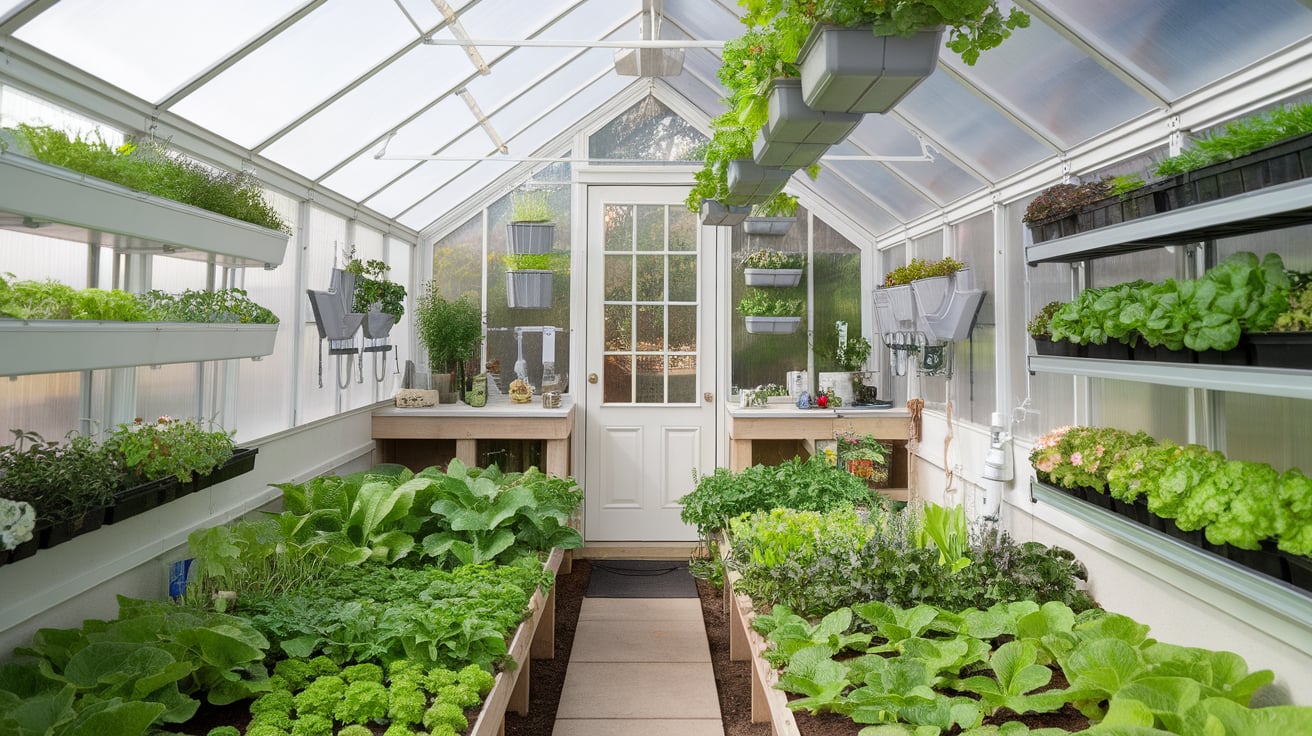Setting up a small greenhouse can feel tricky; there’s only so much space, and it’s easy for things to get messy or crowded.
However, with the right layout, it becomes a lot easier to grow healthy plants and enjoy the space as well.
I’ve put together ideas that show how to use every part of your greenhouse in a smart and useful way.
You’ll find different ways to arrange plants, tools, and shelves so nothing feels cramped or wasted.
I’ve kept it simple and clear, so it’s easy to understand and try out, even if you’re just starting.
These layout tips aren’t just about saving space; they also help your plants get more light, better air, and the care they need.
I want to help you create a greenhouse that works well and looks good, no matter the size. If you’re looking for ideas that really make a difference, you’re about to find them.
What Is a Greenhouse?

A greenhouse is a structure made mostly of glass or clear panels that lets sunlight in and keeps warm air inside. It’s designed to create the best possible environment for growing plants.
By trapping heat and protecting plants from wind, cold, and heavy rain, a greenhouse makes it easier to grow things all year round, even when the weather outside isn’t perfect.
Inside, the temperature stays steadier, and plants get lots of light. This helps seeds sprout faster, flowers bloom longer, and vegetables grow better.
Greenhouses come in many sizes, from large ones on farms to small ones in backyards.
No matter the size, they all work the same way by using light and warmth to help plants grow strong and healthy.
If you enjoy gardening or want to grow your own food, even a small greenhouse can make a big difference. It gives your plants a safe, steady place to thrive.
Key Considerations Before Planning Your Layout
Before you start setting up your greenhouse, it’s smart to think about a few important details.
- Greenhouse Size and Shape: Think about how much space you have and the shape of your greenhouse. This helps decide what layout will fit best.
- Light Direction and Ventilation: Notice where sunlight enters and how air moves. Good light and airflow help plants grow strong and healthy.
- Types of Plants You Want to Grow: Different plants have different needs. Some need more space, warmth, or light than others.
- Accessibility and Workflow: Make sure you can walk around easily and reach your plants without stepping over things. A good setup makes gardening easier and faster.
Inspiring Small Greenhouse Interior Layout Ideas
These ideas show simple ways to set up your space so it stays neat, works well, and helps your plants grow. Each one offers a different way to use your space smartly.
1. Central Walkway with Side Beds
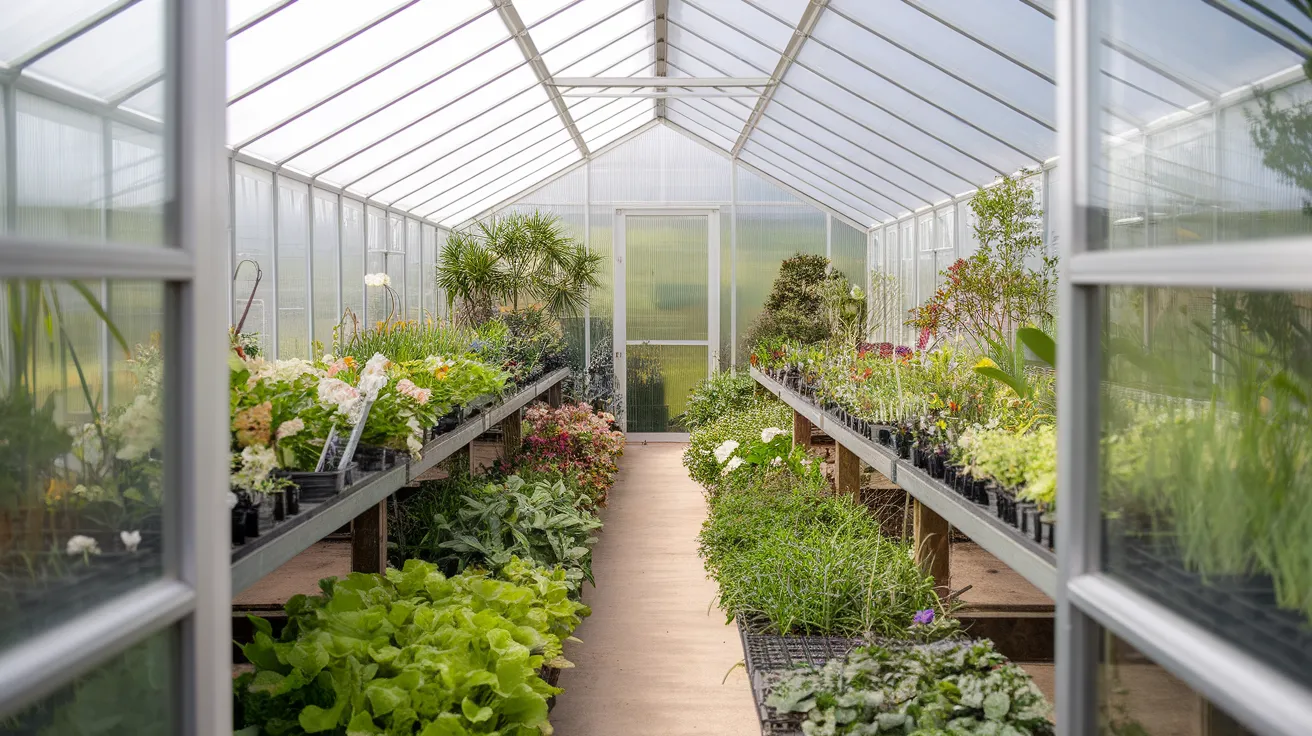
This layout has a path down the middle with planting beds or shelves on both sides.
It’s easy to walk through and reach every plant without stepping on the soil.
You can grow taller plants along the edges and smaller ones near the center. This setup works well for people who want to keep things organized and simple.
It also helps with watering and air flow, since everything is spaced out neatly. If you’re working with a small space, this is a great way to fit in more plants without feeling crowded.
2. U-Shaped Layout with Shelving and Floor Beds

A U-shaped layout wraps your plants around three sides of the greenhouse, leaving the middle open.
You can use shelves on the sides for small pots and place bigger plants on the ground. This setup makes it easy to reach everything while using most of the space.
You’ll have plenty of room for different types of plants and even a small bench or stool to sit on while you work.
It’s a smart way to fit a lot of plants into a small area and still keep the space tidy and easy to move around in.
3. Corner Bench with Tool Storage
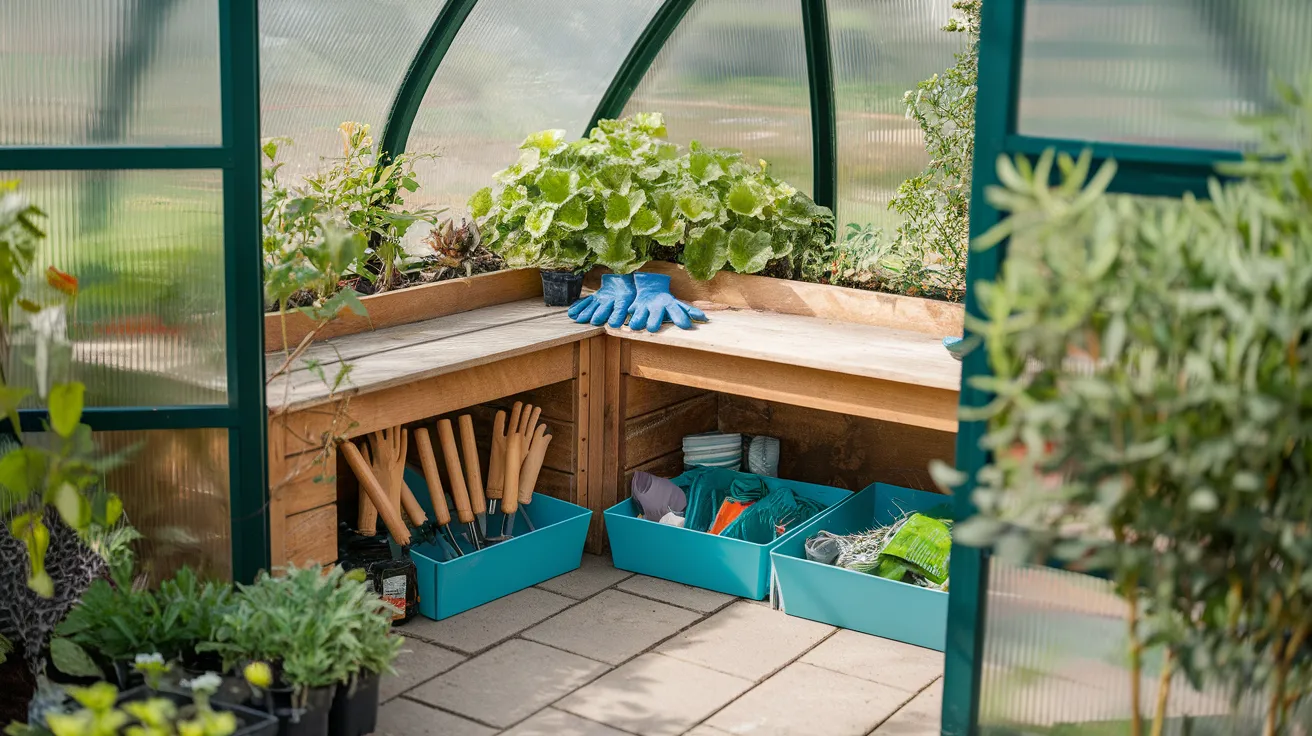
Use one corner of your greenhouse for a small bench that also holds your tools. It saves space and keeps things neat.
You can sit while planting or repotting, and keep your gloves, scissors, and soil close by in boxes or drawers underneath.
This setup works well in tiny greenhouses where every inch counts.
It’s helpful for quick breaks, too! With your tools in one spot, you won’t waste time looking for things.
A corner bench makes your greenhouse feel more organized and makes gardening more comfortable.
4. Hanging Plant Grid System
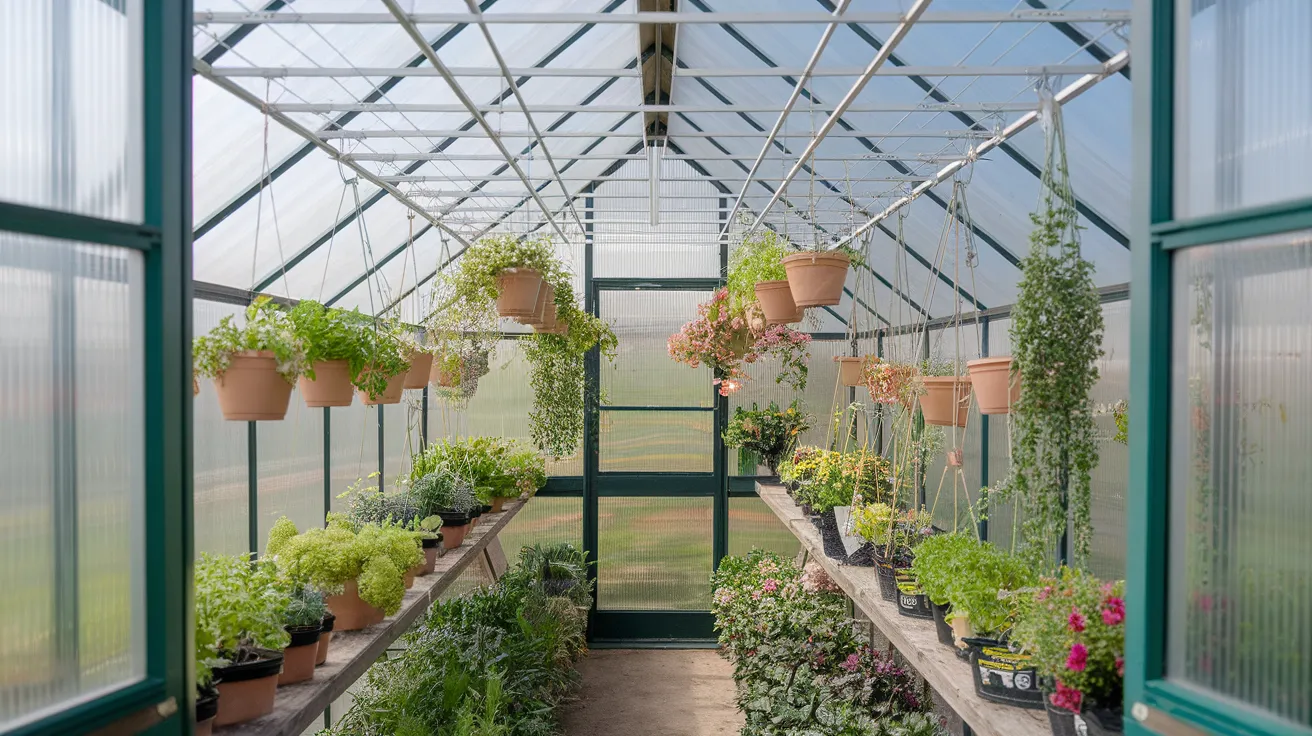
If you run out of room on the ground, look up! A hanging plant grid lets you grow plants from the ceiling.
You can use hooks, bars, or even strong string to hang small pots. This keeps the floor clear and gives your plants more light and air.
It’s great for herbs, flowers, or vines that don’t need deep soil. Just make sure the pots aren’t too heavy.
A hanging system is fun, saves space, and helps you grow more plants, even in a tiny greenhouse.
5. Wall-Mounted Herb Planters
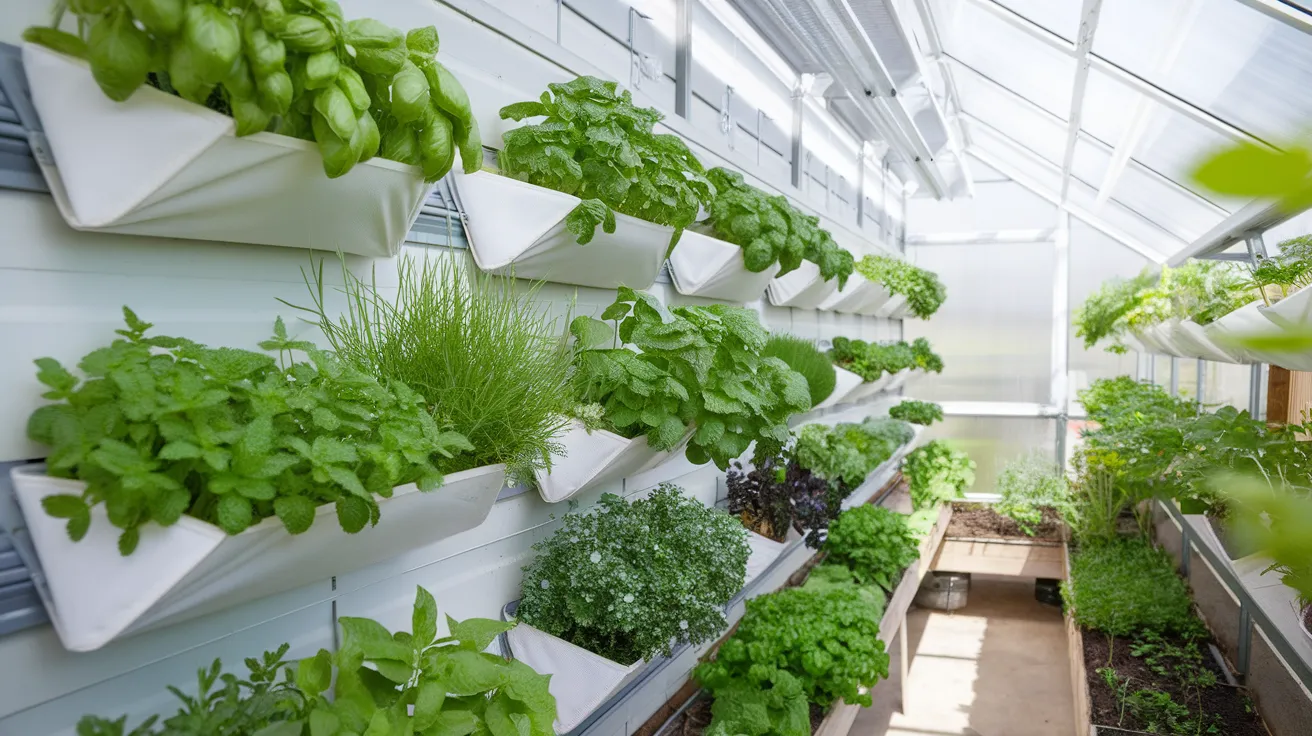
Use your walls for growing! You can hang small planters on a wall to grow herbs like basil, mint, or parsley.
This keeps the ground clear for larger plants and gives you easy access to fresh herbs when you need them.
You can use old boxes, shelves, or fabric pockets to hold the soil. Wall planters are simple to water and care for.
They also make your greenhouse look nice and tidy. It’s a smart way to grow more without taking up space on the floor.
6. Rolling Carts and Mobile Shelves

Using carts or shelves with wheels lets you move your plants and tools around easily.
You can roll them out to clean the space or bring plants closer to sunlight when needed.
This is perfect for small greenhouses where you might need to adjust things often. You can store pots, tools, and even small bags of soil on these carts.
It also helps when you want to change the setup for different seasons.
Rolling storage keeps your space flexible and easy to manage.
7. Compact Potting Station in One Corner

Set up a small table or shelf in one corner for all your planting tasks. This can be your spot for potting, watering, and trimming plants.
Keep your soil, tools, and pots nearby so everything you need is within reach. It makes your greenhouse feel more organized and saves time.
You won’t have to carry things in and out every day.
A compact potting station helps keep mess in one place and makes your gardening routine smoother.
8. Tiered Shelving Against a Single Wall
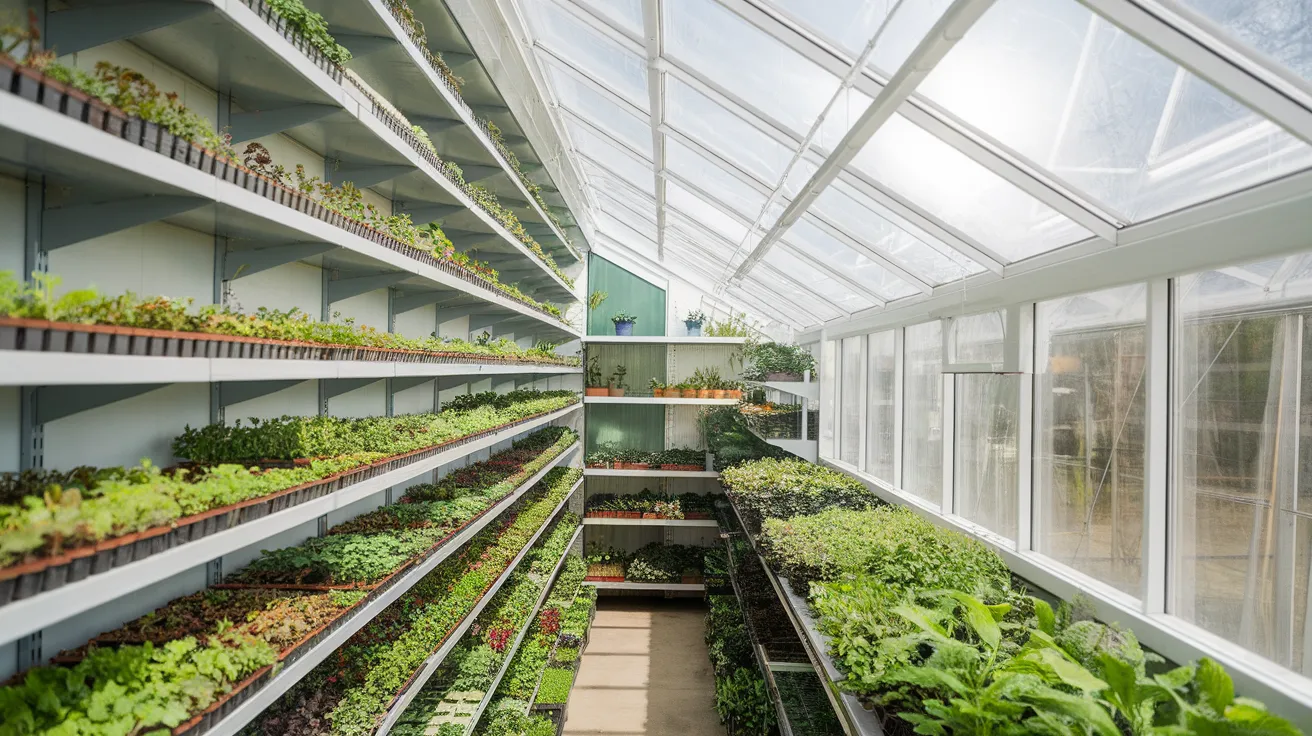
Place tiered shelves along one wall to hold lots of plants in a small space. The shelves can go from the floor to near the ceiling.
This way, every plant gets sunlight, and you have more room to grow. It works best for small and medium pots.
You can water them easily and see all your plants at once. This layout keeps your floor open and your greenhouse looking neat.
It’s a great way to use vertical space without making the area feel crowded.
9. Overhead Storage for Tools and Supplies

Hang small shelves or hooks from the ceiling or top corners to store tools, gloves, and extra supplies.
This keeps your work area clean and gives you more floor space for plants. Make sure it’s safe and doesn’t block light.
Use baskets or boxes to keep everything in place. Overhead storage works well in tiny greenhouses because it uses space that most people forget about.
It helps you stay organized without taking up valuable space.
10. Integrated Watering Zone Near Entry
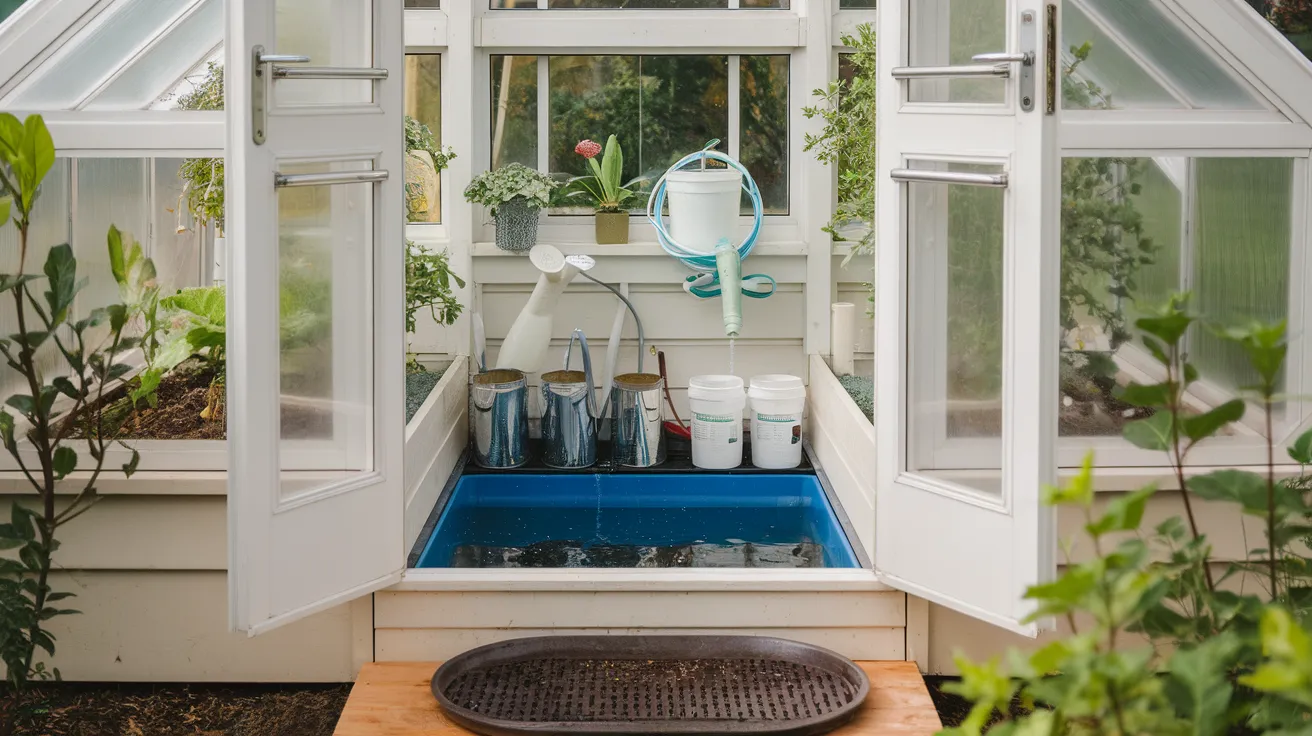
Set up a small space near the door for watering cans, hoses, and maybe even a small sink or bucket.
It’s easier to water plants if everything is in one spot.
This keeps the rest of your greenhouse dry and helps avoid spills. Place a mat or tray underneath to catch water.
Having a watering zone near the entry also makes it easier to fill up or dump out water without walking through the whole greenhouse.
It’s a simple way to stay clean and organized.
11. Zoned Layout: Divide by Plant Needs

Group your plants by what they need-like sunlight, water, or warmth.
Put sun-loving plants near the brightest spot and shade-friendly ones where it’s cooler.
You can also group by how often they need water. This makes it easier to care for them and helps each plant grow better.
It also keeps your greenhouse more organized.
You won’t have to move things around all the time. A zoned layout helps you focus on what each plant needs and saves you time and effort.
12. Circular Planting Arrangement Around a Centerpiece

Place your plants in a circle, leaving space in the middle for a small table or tall plant.
This looks nice and gives easy access to everything.
You can walk around and reach each plant without stepping on anything. It also helps with airflow, which keeps plants healthy.
The middle can be a place for tools, a stool, or a big potted plant.
A circular layout works well in square greenhouses and helps use all corners of the space.
13. Bench Seating That Doubles as Planter Boxes
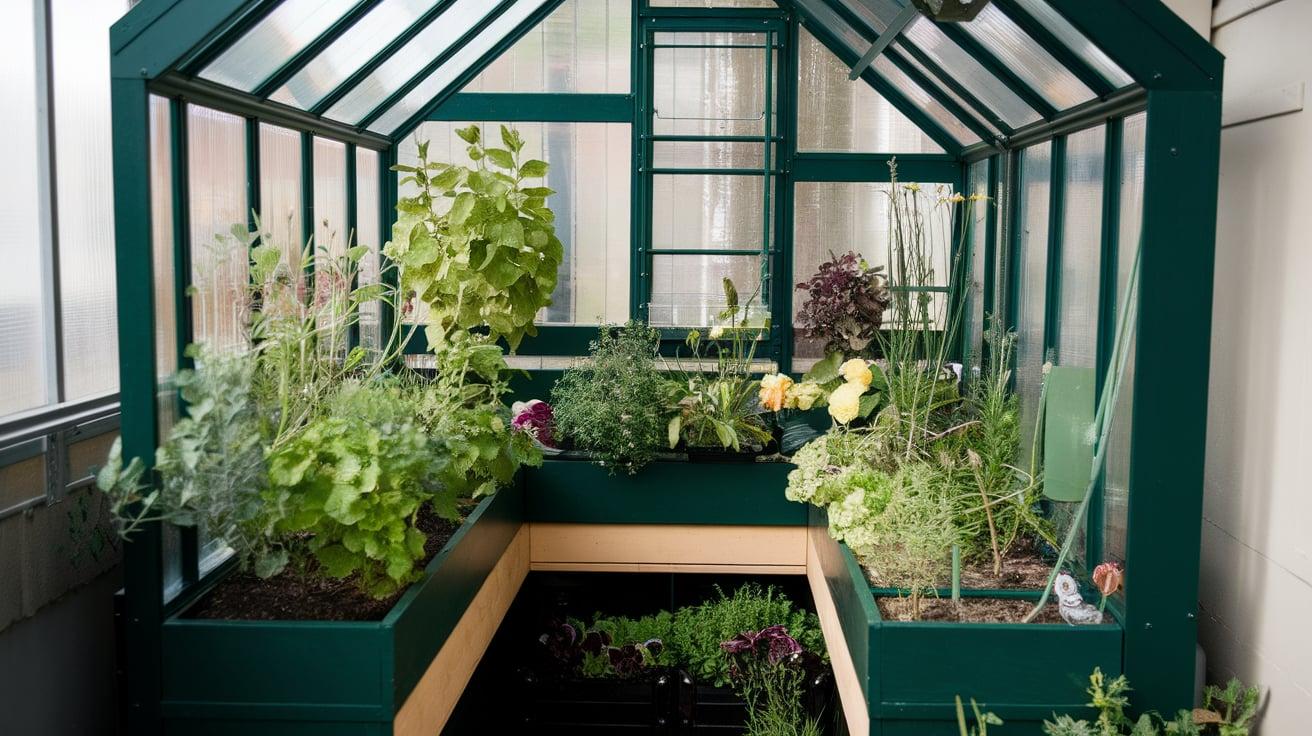
Use a bench that has planter boxes built into it. You can sit while working or resting, and the box underneath can grow herbs or flowers.
This saves space and gives your greenhouse more uses. It’s a fun way to combine seating and planting, especially in very small greenhouses.
You can place the bench against a wall or in a corner.
It makes the space feel cozy and helps you get more done without needing extra room.
14. Clear Floor Space with Hanging Shelves Only

Keep the floor clear by using only hanging shelves. These can be attached to walls or hung from the ceiling.
It gives your plants lots of light and air, and you’ll have plenty of space to move around. This layout is perfect if you want a clean, open feel.
It also makes it easier to sweep or mop the floor. Hanging shelves work best for small pots and lightweight plants.
It’s a simple way to grow more without making the space feel crowded.
15. Work Table with Underneath Plant Storage
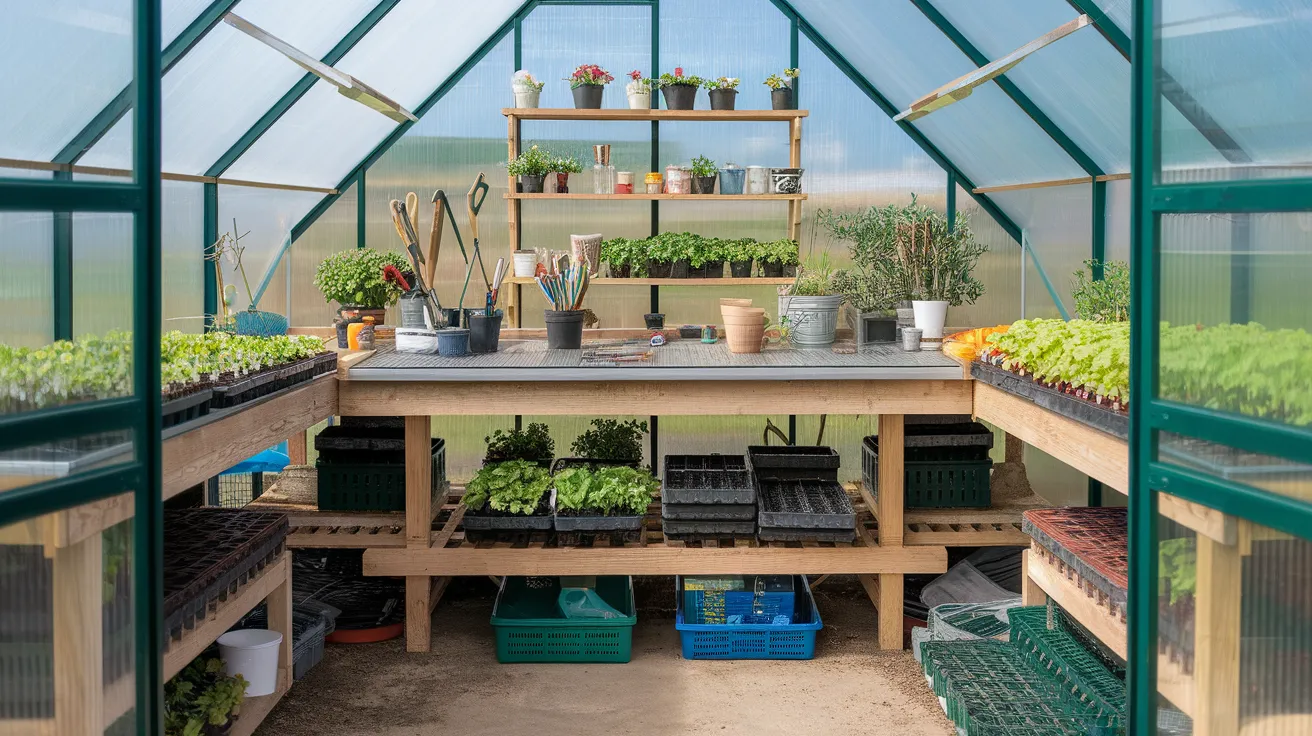
Use a sturdy table for your gardening work, and store plants or supplies underneath. You can place trays, small pots, or boxes on the bottom shelf.
This layout saves space and keeps your tools nearby. It’s also great for planting seeds or repotting plants.
The table gives you a flat surface to work on, and the space below doesn’t go to waste.
It’s a smart way to stay tidy while using every part of your greenhouse.
16. Side-by-Side Narrow Aisles and Beds

Create a few narrow beds with small paths between them. This way, you can grow more plants without taking up too much space for walking.
Each bed can have different types of plants, and you can reach them easily from both sides. It’s perfect for greenhouses that are longer than they are wide.
Keep the paths just wide enough to walk through.
This layout helps you grow a lot, even in a tight area, while keeping things neat and easy to care for.
17. Small Trellis Walls for Vining Plants
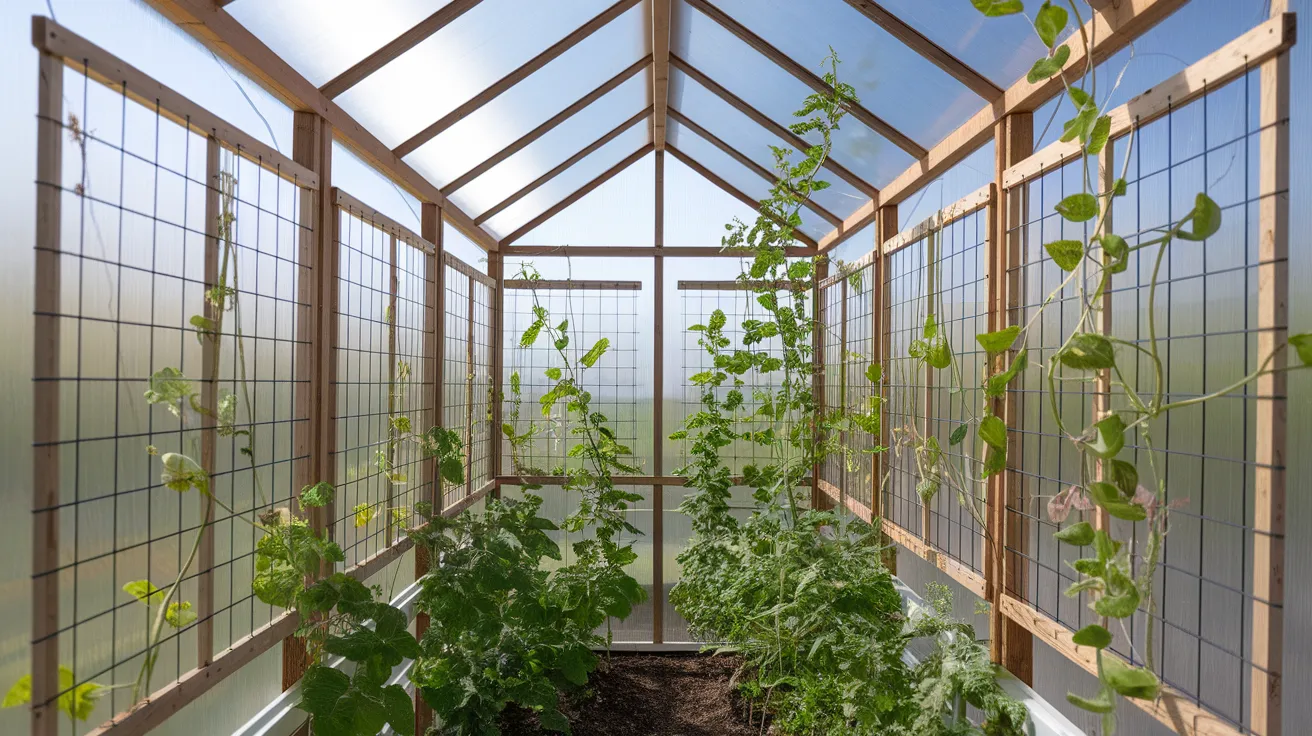
Add trellis panels along the sides or in the corners for climbing plants like peas or beans.
These plants grow up instead of out, so they save space on the ground. Trellises can be wood, wire, or even string.
They give support and help the plants get more light. You can place them along a wall or even hang one from the ceiling.
This is a great way to grow more without using extra floor space.
18. Dedicated Seedling Tray Area Near Light Source
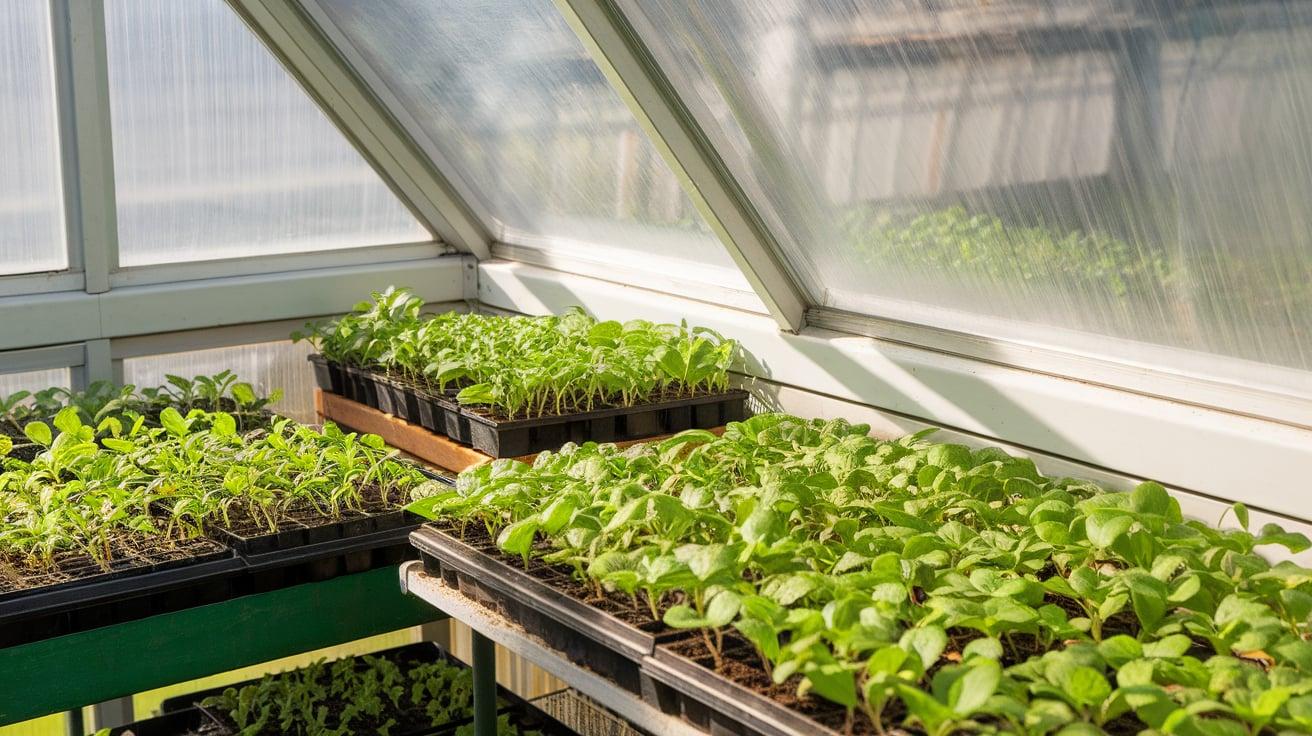
Set up a small table or shelf near the sunniest spot just for seedlings. Seedlings need lots of light and warmth to grow strong.
Use trays or small pots and keep them close together. Having one area just for young plants makes it easier to water and care for them.
It also helps you see how they’re doing without mixing them up with bigger plants.
This is perfect for gardeners who like to start plants from seeds.
19. Low Planters Lining the Outer Walls

Place short planter boxes all along the inside edges of the greenhouse. This leaves the middle open so you can walk or set up a small stool or cart.
It’s a clean layout that’s easy to keep up. You can grow lots of different plants and still move around easily.
The walls help hold in heat, so the plants stay warm.
This layout works well if you like to grow flowers, vegetables, or herbs and want a clear space in the middle.
20. Shelf Tower in a Single Corner

Use a tall shelf in one corner to stack small pots from top to bottom. This uses vertical space and keeps the rest of your greenhouse open.
A shelf tower is great for herbs, succulents, or starter plants. Just make sure the shelves are strong and get enough light.
You can water them easily and see all your plants at once.
This layout works well if you want to keep things simple and organized without using much floor space.
21. Integrated Compost Bin or Organic Waste Corner
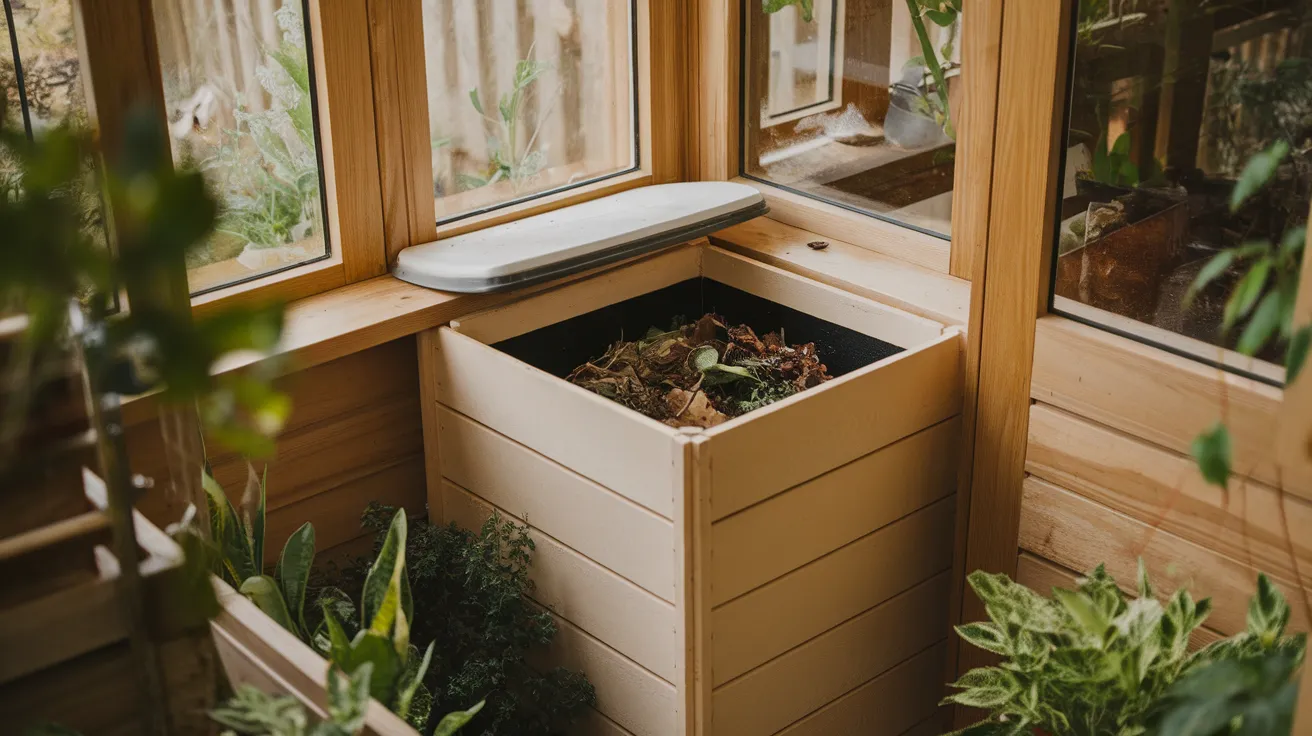
Set aside one small corner for compost. You can use a small bin with a lid to keep it tidy and smell-free.
Put in plant scraps, old leaves, and other garden waste. Over time, this turns into rich soil you can use for your plants.
Having compost right in the greenhouse saves trips to the garden and keeps things eco-friendly.
It’s a smart way to recycle and helps your plants grow even better with natural soil.
Tips for Maximizing Small Greenhouse Space
- Use Vertical Space and Multi-Functional Furniture: Add shelves, hanging planters, or stackable trays to grow upward. Use benches or tables that also store tools or pots.
- Keep Pathways Clear for Easy Movement: Make sure you can walk around without bumping into things. Clear paths help you care for plants and avoid messes.
- Choose Compact or Dwarf Plant Varieties: Pick plants that stay small but still produce well. These take up less space and fit better in tight areas.
Conclusion
Planning the inside of a small greenhouse doesn’t have to be hard. With a few smart ideas, you can turn even the tiniest space into a neat and useful place to grow.
I hope these layout tips gave you new ways to think about your greenhouse.
If you’re growing veggies, herbs, or flowers, the right setup can make everything easier, from watering to harvesting.
I’ve tried to keep things simple and clear so you can start using the ideas right away.
Remember, there’s no one perfect layout. You can mix and match to find what works best for you and your plants.
Take your time, try different setups, and don’t be afraid to make changes. A well-planned greenhouse can save you time, help your plants grow better, and make gardening more fun.
I’m glad I could help you get started, and I hope your greenhouse turns out just the way you want.

